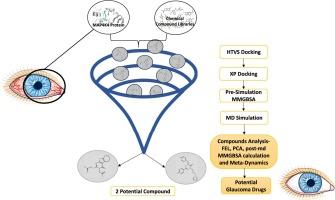利用基于元动力学的解离自由能计算,识别青光眼中 MAP4K4 的潜在抑制剂。
IF 2.7
4区 医学
Q3 NEUROSCIENCES
引用次数: 0
摘要
青光眼是一种导致不可逆视力丧失的眼部常见疾病,全球有超过 2.95 亿人受到青光眼的影响,因此有必要探索新的治疗途径。尽管对磷酸二酯酶和 rho 激酶等靶点进行了广泛的研究,但 MAP4K4 在青光眼中的潜力仍有待开发。本研究旨在找出有效的 MAP4K4 抑制剂,以对抗与青光眼相关的视网膜细胞凋亡和氧化应激。通过 HTVS 和 XP docking,共筛选出 911,059 个化合物。利用 MMGBSA 计算和药代动力学分析筛选出化合物。在进行了 75 次分子动力学模拟后,进一步采用元动力学计算解离自由能,找到潜在的 MAP4K4 抑制剂。研究结果表明,ZINC06717217 和 ZINC38836256 的对接得分分别为 -9.57 和 -11.12,MMGBSA 结合能分别为 -91.07 kcal/mol 和 -87.52 kcal/mol,表现出显著的前景。与参比化合物 Q27453723 的比较分析表明,它们具有极高的稳定性,脱离对接复合物所需的无解离能分别为 -15.11 kcal/mol 和 -12.46 kcal/mol。这凸显了它们强大的结合亲和力。ZINC06717217 和 ZINC38836256 显示出良好的稳定性以及与 MAP4K4 蛋白的强结合力。因此,这些研究结果有望抑制 MAP4K4 以治疗青光眼,从而提高治疗效果并治愈失明。关键信息:首次将无离解能用于识别治疗青光眼的化合物。通过分子内分析发现,ZINC06717217 和 ZINC38836256 是有望靶向 MAP4K4 的化合物。本文章由计算机程序翻译,如有差异,请以英文原文为准。

Identification of potential inhibitors for MAP4K4 in glaucoma using meta-dynamics-based dissociation free energy calculation
Glaucoma, a prevalent eye ailment causing irreversible vision loss, affects over 295 million individuals globally, necessitating the exploration of novel therapeutic avenues. Despite extensive research on targets like the phosphodiesterase enzyme and rho kinase, the potential of MAP4K4 in glaucoma remains untapped. This study aims to identify potent MAP4K4 inhibitors to counteract retinal cell apoptosis and oxidative stress associated with glaucoma. Using HTVS and XP docking, 911,059 compounds were screened. The MMGBSA calculation and pharmacokinetics analysis were used to shortlist the compounds. After performing 75 molecular dynamics simulations, further meta-dynamics were employed to calculate dissociation-free energy and find potential MAP4K4 inhibitors. Findings indicated that ZINC06717217 and ZINC38836256 exhibited remarkable promise, with docking scores of −9.57 and −11.12 and MMGBSA binding energies of −91.07 kcal/mol and −87.52 kcal/mol, respectively. Comparative analysis with the reference compound Q27453723 underscored their superior stability, requiring dissociation-free energies of −15.11 kcal/mol and −12.46 kcal/mol to disengage from the docked complex. This underscored their robust binding affinity. ZINC06717217 and ZINC38836256 show promising stability and strong binding to the MAP4K4 protein. Hence, these findings are promising in inhibiting MAP4K4 for glaucoma treatment, potentially leading to more effective treatment and curing blindness.
Key messages
First to incorporate the dissociation-free energy for identifying compounds for glaucoma treatment.
In-silico analysis showed that ZINC06717217 and ZINC38836256 are promising compounds for targeting MAP4K4.
求助全文
通过发布文献求助,成功后即可免费获取论文全文。
去求助
来源期刊

Brain Research
医学-神经科学
CiteScore
5.90
自引率
3.40%
发文量
268
审稿时长
47 days
期刊介绍:
An international multidisciplinary journal devoted to fundamental research in the brain sciences.
Brain Research publishes papers reporting interdisciplinary investigations of nervous system structure and function that are of general interest to the international community of neuroscientists. As is evident from the journals name, its scope is broad, ranging from cellular and molecular studies through systems neuroscience, cognition and disease. Invited reviews are also published; suggestions for and inquiries about potential reviews are welcomed.
With the appearance of the final issue of the 2011 subscription, Vol. 67/1-2 (24 June 2011), Brain Research Reviews has ceased publication as a distinct journal separate from Brain Research. Review articles accepted for Brain Research are now published in that journal.
 求助内容:
求助内容: 应助结果提醒方式:
应助结果提醒方式:


